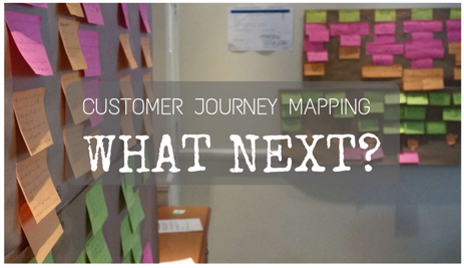The biggest risks to our Customer Experience efforts

When people with different agendas build an experience, what could possibly go wrong…?
Ambition, commitment and perseverance. All three are critical to success but a weakness in any one of them is a huge risk to our Customer Experience plans. It will almost certainly ensure we don’t achieve what we set out to. While we focus on doing things in a new way it’s every bit as important to be aware of the warning signs that the old, destructive ways haven’t yet evaporated totally.
From what I’ve seen the most effective approaches to customer experience have three things in common. They have people who are passionate about their subject and a deep understanding of what it’s like being a customer. Critically though, they also enjoy a culture where the first two are allowed to thrive.
I’m often asked how organisations can cultivate those three ingredients; what should they do when they set out to become more customer-centric? There’s a long list to work through. So assuming those things are in place, once the Customer Experience momentum is up and running what could possibly go wrong? Another long list, this time of spanners that are poised to throw themselves into the works – if we let them.
As a CEO recently told me: “If we don’t keep pedalling uphill, gravity takes over, all the effort is wasted and we’re back to square one before we know it”.
In this post I’ve highlighted just three of the biggest risks; different agendas, the day job and an obsession with metrics. They’re inextricably linked and will be of little surprise but they are chosen because, from my observations inside a wide variety of businesses, if the ambition, commitment and perseverance isn’t genuine enough these risks have a habit of becoming very real issues.
First up, people working to different agendas.
When employees have divergent priorities, whether they are just following their leader’s instructions or there is simply no common purpose, we get silos. It’s a convenient label that somehow explains, excuses and – worse – gives credibility to value-destroying ways of working.
You know you’ve got silos when you ask 10 people in a meeting room why the business exists or what the customer strategy is and you get 10 or more different answers. At best, there are variations on a theme, often educated guesses and sometimes no answer at all. Nor do they seem bothered, they’ve got their job to do (see below).
A large player in the financial services sector had an internal goal “to be the best”. It was admirable and aspirational but no-one knew exactly what that meant. The highest savings rates and lowest mortgage rates in the market? Or widest net interest margin? Highest adoption rates of its app of any company in the world?
Despite the cleverly-worded posters on the wall about putting customers first, if there is not some common, meaningful customer purpose and metrics that everyone has a vested interest in there’s no way any cross-functional improvements will happen.
As a result of the fog, everyone carries on doing the things they do have clarity about. They know how their boss is going to decide whether they are meeting or exceeding expectations in the annual review and that’s their priority. No surprise therefore that we then see tensions, politics and stress with all the consequences that leads to.
Meanwhile, all the good customer-centric intent has rolled back down to the bottom of the hill.
The day-job default.
While part of the business is embracing Customer Experience with raw passion, the reality is that there is also a day-job to do be done. Sadly, it’ll stay that way until Customer Experience becomes just the way things are done rather than CX being seen as a function or division – and therefore seen an ‘optional extra’.
That might be because many of those who are asked to go and ‘do’ customer experience are having the responsibility added to their existing workload. Or at an organisational level, there’s just too much noise going on for anything new to make itself heard. Some don’t get it, others don’t want to get it and a few get it but resist a move out of their comfort zone.
It’s very easy to run a customer strategy session, a journey mapping workshop or an ethnographic study and then while the notes are being written up and we get it on the next Steering Group agenda, attention turns to the more ‘important and urgent’ things in our inbox. There might be a seasonal spike in activity that needs all hands on deck. “Project Invincible” has meeting coming up that needs a cast of thousands to attend or a new campaign is due to launch and that’s taking all available resource. Lots of reasons, but are they plausible or just a convenient excuse?
Because Customer Experience in its purest sense is about a cultural mindset, when there’s lots of firefighting to be done today it’s often seen as something discretionary, something that can wait until tomorrow. But we know how often tomorrow comes.
An obsession with the score not the experience
I’ve always taken the line that if we get the experience right first, the numbers will look after themselves. Of course, whichever measurement method we choose we need to know what drives the numbers or drags them back but at least that means we’re looking at things from a customer’s perspective. Chasing the number is purely a vanity exercise.
A rallying cry to increase a customer score by 10 points might sound admirable, and it is. The issue is the way the business then sets about increasing the score. Without robust governance in place, those running the surveys will be coerced into changing the way the feedback is collected; they’re told to ask only those who’ve gone through the complete purchase cycle rather than include those who dropped out half-way. Customers will be offered incentives for giving higher scores or respondents will be given a false scale to flatter the real score.
Gaming the system is a real issue for many businesses and not all of them are aware that it goes on within their organisation. If you’re interested or concerned and want more food for thought, I wrote about a culture where the numbers are more important than people in this blog.
It’s one reason why we’re seeing more companies adopting the scores from independent review sites such as Trustpilot, Google and TripAdvisor as their key customer metric.
What to do about them?
There’s no rocket science here and there will be other issues that can derail our best Customer Experience efforts. Like gravity, we can only escape their pull with a bit of effort. They have patience and we have to assume they’ll wait a long time, hoping for changes or a weakness to appear.
But if we share the principles of the Customer Strategy and show employees how the brand promises to treat its customers, if we have a governance process that informs and involves people from every corner of the business, if we ensure there is a visible commitment from the top that this is a priority for the business and if we have common customer metrics in everyone’s scorecard the risks have to be much, much lower. We’ll stay ahead of competitors and keep up with rising expectations too.
To say they are all obvious issues is, well, obvious. But if they are so well known, why do they keep getting in the way and what can we do about them? I’d love to know what you think.
Thank you for reading the blog on what can derail CX efforts, I hope you found it thought-provoking.
I’m Jerry Angrave and I help Customer Experience people do what they need to do. I’m a CCXP (Certified Customer Experience Professional) and am one of a handful of people globally who are authorised by the CXPA to train CX professionals for its accreditation. I founded Empathyce after a long career in CX and Marketing roles and am now a consultant and trainer. I give CX professionals the skills, tools and confidence to be the ones to drive their Customer Experience efforts forward.
Do get in touch if you’ve any comments on the blog, any questions or are interested in training or consultancy support.
Thank you,
Jerry
[email protected] | www.empathyce.com | +44 (0) 7917 718 072


 CX consultant with an extensive corporate background and I also specialise in professional development for those in, or moving to, customer experience roles. Feel free to contact me with any questions – by email to
CX consultant with an extensive corporate background and I also specialise in professional development for those in, or moving to, customer experience roles. Feel free to contact me with any questions – by email to 




